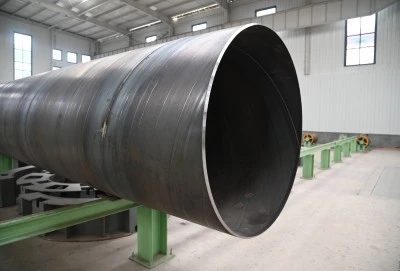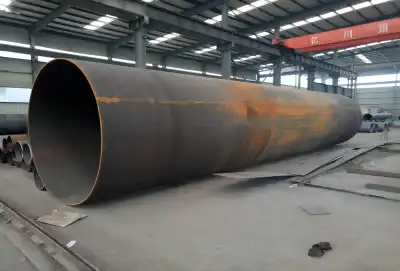In the world of steel pipe manufacturing, two prominent types stand out: Spiral Submerged Arc Welded (SSAW) and Longitudinal Submerged Arc Welded (LSAW) steel pipes. Both play crucial roles in various industries, including oil and gas, water transportation, and construction. Understanding the differences between these two types of pipes is essential for engineers, project managers, and procurement specialists to make informed decisions when selecting the most suitable option for their specific applications.
SSAW Steel Pipe and LSAW pipe are both large-diameter welded pipes used in numerous industrial applications. However, they differ significantly in their manufacturing processes, performance characteristics, and suitability for various projects. This article will explore the key differences between SSAW and LSAW steel pipes, their respective advantages and limitations, and guide on choosing the right type for your specific needs.
|
|
|
SSAW pipes are welded in the helix or spiral position while LSAW pipes are welded in the longitudinal direction:
The primary distinction between SSAW and LSAW steel pipes lies in their welding orientation. This fundamental difference affects not only the manufacturing process but also the pipes' structural characteristics and performance in various applications.
SSAW Steel Pipe, as the name suggests, is created using a spiral or helical welding technique. In this process, a continuous steel strip or plate is fed into a forming machine at an angle, which then bends it into a spiral shape. As the spiral is formed, the edges are welded together using the submerged arc welding (SAW) method. This results in a continuous helical weld seam that runs along the entire length of the pipe.
The spiral welding process offers several advantages. It allows for the efficient production of large-diameter pipes from narrower steel coils, reducing material waste and enabling the manufacture of pipes with diameters ranging from 219mm to 3500mm. Additionally, the spiral weld distributes stress more evenly around the circumference of the pipe, potentially enhancing its overall strength and resistance to external pressures.
In contrast, LSAW pipes are manufactured using a longitudinal welding technique. This process begins with a steel plate that is first formed into a cylindrical shape, typically using a press or roll bending machine. The edges of the plate are then brought together and welded along the length of the pipe using the submerged arc welding method. This results in a straight weld seam that runs parallel to the pipe's axis.
The longitudinal welding process used in LSAW pipe production allows for greater control over the pipe's dimensions and wall thickness. It's particularly well-suited for producing pipes with very large diameters (up to 5500mm) and thick walls, which are often required in high-pressure applications or deep-sea environments.
The orientation of the weld seam in LSAW pipes (parallel to the pipe's axis) means that the primary stresses in applications like high-pressure pipelines are perpendicular to the weld. This configuration can provide superior performance in certain high-stress scenarios compared to SSAW pipes, where the helical weld may experience a combination of longitudinal and circumferential stresses.
LSAW Pipes has better performance than SSAW Pipes:
While both SSAW Steel Pipe and LSAW pipe have their merits, LSAW pipes are generally considered to offer superior performance in certain critical applications. This performance advantage stems from several factors related to their manufacturing process and structural characteristics.
Firstly, the longitudinal welding process used in LSAW pipe production allows for better control over the pipe's dimensional accuracy. The straight weld seam enables manufacturers to achieve tighter tolerances in terms of diameter, ovality, and wall thickness. This precision is particularly crucial in applications where exact fit and alignment are essential, such as in offshore pipelines or when connecting pipe sections in demanding environments.
Secondly, LSAW pipes typically exhibit superior mechanical properties, especially in terms of strength and toughness. The longitudinal weld orientation aligns better with the primary stresses experienced in high-pressure pipelines, where the hoop stress (circumferential stress) is twice the longitudinal stress. This alignment allows LSAW pipes to withstand higher internal pressures and external loads more effectively than their SSAW counterparts.
The manufacturing process of LSAW pipes also contributes to their enhanced performance. The use of wider steel plates allows for better control over the steel's microstructure and properties throughout the pipe's circumference. This uniformity results in more consistent mechanical properties and improved resistance to various types of failure mechanisms, including stress corrosion cracking and hydrogen-induced cracking.
Furthermore, LSAW pipes generally demonstrate superior fatigue resistance. The straight weld seam experiences less complex stress patterns compared to the helical weld in SSAW pipes, potentially reducing the risk of fatigue-related failures in cyclic loading conditions. This characteristic makes LSAW pipes particularly suitable for applications involving frequent pressure fluctuations or dynamic loads, such as in offshore risers or subsea pipelines.
In terms of weld quality, LSAW pipes often have an advantage. The longitudinal welding process allows for easier access and control during welding and inspection procedures. This facilitates the production of high-quality welds with fewer defects and enables more thorough non-destructive testing, contributing to the overall reliability and safety of the pipe.
However, it's important to note that while LSAW pipes generally offer better performance, SSAW Steel Pipe remains a viable and cost-effective option for many applications. SSAW pipes are often more economical to produce, especially in smaller diameters, and can be manufactured in longer continuous lengths. They also perform well in many standard pipeline applications where the performance advantages of LSAW pipes may not be critical.
SSAW Steel Pipe and LSAW Steel Pipe manufacturer:
LONGMA GROUP is a reputable manufacturer of LSAW Steel Pipe and SSAW steel pipe, offering products that meet a wide range of international standards.
For those in the market for high-quality SSAW steel pipes and SSAW steel pipes, LONGMA GROUP welcomes inquiries and can provide detailed information about their products and services. Interested parties can reach out to the company at info@longma-group.com to discuss their specific requirements and explore how LONGMA GROUP's steel pipes can meet their project needs.














